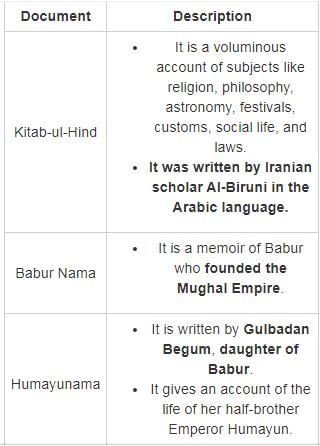UPSC Exam > UPSC Questions > Which chronicles and documents from the Mugh...
Start Learning for Free
Which chronicles and documents from the Mughal court are the major sources for the agrarian history of the sixteenth and early seventeenth century?
- a)Ain-i-Akbari
- b)Kitab-ul-Hind
- c)Babur Nama
- d)Humayunama
Correct answer is option 'A'. Can you explain this answer?
| FREE This question is part of | Download PDF Attempt this Test |
Most Upvoted Answer
Which chronicles and documents from the Mughal court are the major so...
- Ain-i-Akbari is a 16th-century document detailing the administration under Mughal Emperor Akbar.
- It was written by Akbar’s court historian Abu’l Fazl in the Persian language.
- It forms the third and final part of Akbarnama, which is a complete account of Akbar.
Additional Information

Attention UPSC Students!
To make sure you are not studying endlessly, EduRev has designed UPSC study material, with Structured Courses, Videos, & Test Series. Plus get personalized analysis, doubt solving and improvement plans to achieve a great score in UPSC.

|
Explore Courses for UPSC exam
|

|
Similar UPSC Doubts
Which chronicles and documents from the Mughal court are the major sources for the agrarian history of the sixteenth and early seventeenth century?a)Ain-i-Akbarib)Kitab-ul-Hindc)Babur Namad)HumayunamaCorrect answer is option 'A'. Can you explain this answer?
Question Description
Which chronicles and documents from the Mughal court are the major sources for the agrarian history of the sixteenth and early seventeenth century?a)Ain-i-Akbarib)Kitab-ul-Hindc)Babur Namad)HumayunamaCorrect answer is option 'A'. Can you explain this answer? for UPSC 2025 is part of UPSC preparation. The Question and answers have been prepared according to the UPSC exam syllabus. Information about Which chronicles and documents from the Mughal court are the major sources for the agrarian history of the sixteenth and early seventeenth century?a)Ain-i-Akbarib)Kitab-ul-Hindc)Babur Namad)HumayunamaCorrect answer is option 'A'. Can you explain this answer? covers all topics & solutions for UPSC 2025 Exam. Find important definitions, questions, meanings, examples, exercises and tests below for Which chronicles and documents from the Mughal court are the major sources for the agrarian history of the sixteenth and early seventeenth century?a)Ain-i-Akbarib)Kitab-ul-Hindc)Babur Namad)HumayunamaCorrect answer is option 'A'. Can you explain this answer?.
Which chronicles and documents from the Mughal court are the major sources for the agrarian history of the sixteenth and early seventeenth century?a)Ain-i-Akbarib)Kitab-ul-Hindc)Babur Namad)HumayunamaCorrect answer is option 'A'. Can you explain this answer? for UPSC 2025 is part of UPSC preparation. The Question and answers have been prepared according to the UPSC exam syllabus. Information about Which chronicles and documents from the Mughal court are the major sources for the agrarian history of the sixteenth and early seventeenth century?a)Ain-i-Akbarib)Kitab-ul-Hindc)Babur Namad)HumayunamaCorrect answer is option 'A'. Can you explain this answer? covers all topics & solutions for UPSC 2025 Exam. Find important definitions, questions, meanings, examples, exercises and tests below for Which chronicles and documents from the Mughal court are the major sources for the agrarian history of the sixteenth and early seventeenth century?a)Ain-i-Akbarib)Kitab-ul-Hindc)Babur Namad)HumayunamaCorrect answer is option 'A'. Can you explain this answer?.
Solutions for Which chronicles and documents from the Mughal court are the major sources for the agrarian history of the sixteenth and early seventeenth century?a)Ain-i-Akbarib)Kitab-ul-Hindc)Babur Namad)HumayunamaCorrect answer is option 'A'. Can you explain this answer? in English & in Hindi are available as part of our courses for UPSC.
Download more important topics, notes, lectures and mock test series for UPSC Exam by signing up for free.
Here you can find the meaning of Which chronicles and documents from the Mughal court are the major sources for the agrarian history of the sixteenth and early seventeenth century?a)Ain-i-Akbarib)Kitab-ul-Hindc)Babur Namad)HumayunamaCorrect answer is option 'A'. Can you explain this answer? defined & explained in the simplest way possible. Besides giving the explanation of
Which chronicles and documents from the Mughal court are the major sources for the agrarian history of the sixteenth and early seventeenth century?a)Ain-i-Akbarib)Kitab-ul-Hindc)Babur Namad)HumayunamaCorrect answer is option 'A'. Can you explain this answer?, a detailed solution for Which chronicles and documents from the Mughal court are the major sources for the agrarian history of the sixteenth and early seventeenth century?a)Ain-i-Akbarib)Kitab-ul-Hindc)Babur Namad)HumayunamaCorrect answer is option 'A'. Can you explain this answer? has been provided alongside types of Which chronicles and documents from the Mughal court are the major sources for the agrarian history of the sixteenth and early seventeenth century?a)Ain-i-Akbarib)Kitab-ul-Hindc)Babur Namad)HumayunamaCorrect answer is option 'A'. Can you explain this answer? theory, EduRev gives you an
ample number of questions to practice Which chronicles and documents from the Mughal court are the major sources for the agrarian history of the sixteenth and early seventeenth century?a)Ain-i-Akbarib)Kitab-ul-Hindc)Babur Namad)HumayunamaCorrect answer is option 'A'. Can you explain this answer? tests, examples and also practice UPSC tests.

|
Explore Courses for UPSC exam
|

|
Suggested Free Tests
Signup for Free!
Signup to see your scores go up within 7 days! Learn & Practice with 1000+ FREE Notes, Videos & Tests.
























